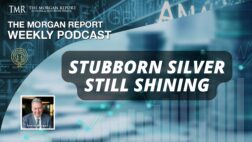Ellis Martin: We’re joined now by the silver guru, David Morgan, of The Morgan Report. David, welcome back to The Opportunity Show.
David Morgan: My pleasure, Ellis.
Mr. Martin: How have the precious metals markets changed in the last five to ten years, David?
Mr. Morgan: I think we can look at it kind of sector by sector, but I think one of the big things that’s changed is the amount of interest in the markets. First, just look at the number of Web sites that are devoted to the precious metals today, versus how many were available when I started, say, ten years ago or so. In the silver arena there was Ted Butler, Frank Sanders, and me. I’m sure there were other people, but as far as fairly well known personalities, we were “it.” Today, you have many, many people in the sector. In fact most of them who have come up strongly, I know personally: Sean Rakhimov at silverstrategies.com; Kenny Parsons, Silver Bear Café; my friend Mike Maloney, goldsilver.com. . . . And Jason Hommel has come on; he was one of my early subscribers, as a matter of fact. So, a lot more interest in the sector, a lot more Web sites devoted to the sector. That is just one area that significantly shows increase in not only knowledge but interest in this area.
Mr. Martin: You really stand out amongst that group, though. You’ve received a lot of press lately. How do you account for that, without sounding self-indulgent?
Mr. Morgan: Well, staying on the theme about what’s changed in the last several years, it’s again interest in the market. The aspect I just mentioned, Web sites, is really one of the smaller arenas. The big arena is the metal itself. This is where you’ve seen the advent of the ETFs that have come on to the scene here in the last several years—primarily the gold ETF initially, and then there was some quandary about whether there would be a silver ETF. I wrote several articles (silverinvestor.com archives), expressing that whatever is good for gold is good for silver, that eventually a silver ETF would exist. Lo and behold, there’s not only one now, there are several.
So this has brought a great deal more buying pressure into the market, because most of the fund managers or managed money in the ETFs are restricted from buying the commodity. If you’re managing money, your mandate is that you can buy any stock out there. But, in fact, there are certain limits on the stocks that you can buy. You can’t buy a lot of penny stocks in most cases. Any stock that meets particular criteria you can buy, but you cannot buy anything in the futures markets. And since the ETF is basically a commodity that trades as a share, you’ve now got a huge interest in this market and that has definitely brought a lot more attention to the gold and silver markets.
So how do I stand out? I think that there are always people on these financial channels looking for input and I’m one name among many that’s recognizable. I’ll get a phone call inviting me to appear on a show, be interviewed, or whatever. I’ve been at it for a while, and that’s created some name recognition for me and I’m glad to get the publicity, but there are several of us who do this, and that’s great. I appreciate your comment, Ellis, and I do work very hard as you know, but there’s a lot of good stuff and several sources to choose from. The truth of it is that all of us in the industry pretty much read each other’s work. I read several of the other writers and sometimes they spawn new ideas, sometimes they don’t, and sometimes they’re contradictory to your thinking. You know, that’s all good. It all makes the world go round and helps to sharpen my thinking. I welcome all of it.
Mr. Martin: I’m a retail investor . . . I’m taking a look at the silver ETF, I’m taking a look at silver bullion, and I’m looking at silver stocks. Aside from possibly investing in all three, how would you help me make my decision without telling me what to do, David?
Mr. Morgan: My thinking is very simple. The first thing I want out of my investment in this sector is something that I feel stands alone outside of the system. The only things that do that are coins in hand or bullion in hand. So my first purchase, and I recommend it from the start, is to have the physical gold or silver in hand.
Once that’s accomplished I like to see some safe leverage, if there is such a thing. Whenever there’s leverage involved it means higher risk and that’s a fact. But I have learned during the thirty years I’ve been doing this that the best risk-to-reward profile is actually in the top tier, cash rich, unheard mining shares. As long as you do it for cash—in other words, buy the shares without margin—you’re pretty safe. Not that these prices don’t go up and down, but you get sometimes equal leverage to a futures account without the risk of a futures account, where you put up minimum margin and as soon as the market goes against you, you get a margin call. So I like the mining equities. I divide them into two sectors: top tier companies, where we put serious money for serious companies; and speculative, where you put in a little money to win a lot. That’s how I have advocated investing or speculating in the sector from the get-go, and I continue on that theme.
On the ETFs, I’m neutral to positive on them. I mean certainly this is more of a realm for the institutional investor, the hedge fund manager, or very, very wealthy retail clients. I don’t think it’s the best choice for your average investor, although it’s a very easy one because it’s a stock and you can just click your mouse (if you have an electronic trading platform) and buy or sell the shares. So from a liquidity standpoint, they’re excellent. But I don’t think that would be my first choice.
Mr. Martin: It’s not necessarily your choice of highest return in the long term, is it?
Mr. Morgan: No. I think the highest return that can be proven so far in this bull market has been in the mining equities. However, if you did it right, the highly leveraged options or futures market can certainly make a great deal of money in a very short period of time.
We had Silver Standard recommended when it was under a dollar; it’s been as high as $40.00, and now it’s in the $20.00 range. So if you bought Silver Standard at $20.00 a few years back, you watched it go down to about $5.00 last November then back up to $20.00 now, so you’re even. Pan American was under $2.00, and it’s done about the same as Silver Standard. Many of these stocks have had huge gains. The problem is that a lot of people came into the sector, and for the last couple of years these stocks have been basically flat.
These markets climbed a wall of worry, all global markets do. There are these long pauses or hesitations, what I like to refer to as consolidation periods. Once those consolidation periods end, and I believe we’re ending now, you get ready for the next leg up.
Mr. Martin: We’ll continue our conversation with the silver guru, David Morgan, in the next segment.



